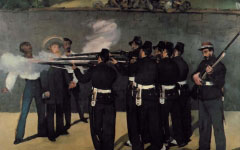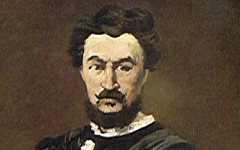Manet’s The Suicide (c.1871)
In Manet’s Suicide the victim still holds the gun with which he shot himself, a hint either that we are witnessing the very moment that he shot himself or that all is not quite what it seems. That feature has intrigued Manet specialists before: a dead man would have dropped the gun.1 The man, of course, is a painter. His shirt is white like a blank canvas. The gun is “his brush” and, in "shooting" himself, the man has painted himself equating the liquid of life with the essence of paint. Besides, as noted elsewhere, the word execution often signifies the making of an artwork while death symbolizes its completion.
Just as Titian, Van Dyck and other artists yearned for the recognition of a ruler through the gift of a gold chain and depicted those chains in their paintings so Manet, in the nineteenth century, yearned for the Légion d’Honneur, France’s highest honor, to indicate that he, like great masters before him, had been honored by the State. It was a constant leitmotif in Manet's art, still unrecognized by specialists today. That is why the red wound on the white shirt resembles the short red ribbon of the Legion d’Honneur. The dead man is “a great artist.”
See conclusion below
The date of this painting is uncertain but Manet probably painted it before he received the Légion d’Honneur in 1881. Nevertheless, hidden symbols for the honor first appeared in his work at the very start of his career, in the early 1860's.2
More Works by Manet
Art scholars have sometimes wondered why the execution squad in Manet's Execution of Emperor Maximillian are so unrealistically close to their target. Indeed, on close inspection, their rifles are aimed as though they would miss.

Manet’s Execution of Emperor Maximillian (1867-8)
Notes:
1. Ulrike Ilg, “Painted Theory of Art: Le Suicidé (1877) by Edouard Manet and the Disappearance of Narration”, Artibus et Historiae 23, 2002, p. 179
2. The earliest use of a hidden symbol in Manet's oeuvre for the Legion d'Honneur, at least that I have found, is the string of large red rosettes in Lola da Valence in 1862.
Original Publication Date on EPPH: 07 Sep 2010. | Updated: 0. © Simon Abrahams. Articles on this site are the copyright of Simon Abrahams. To use copyrighted material in print or other media for purposes beyond 'fair use', you must obtain permission from the copyright owner. Websites may link to this page without permission (please do) but may not reproduce the material on their own site without crediting Simon Abrahams and EPPH.



